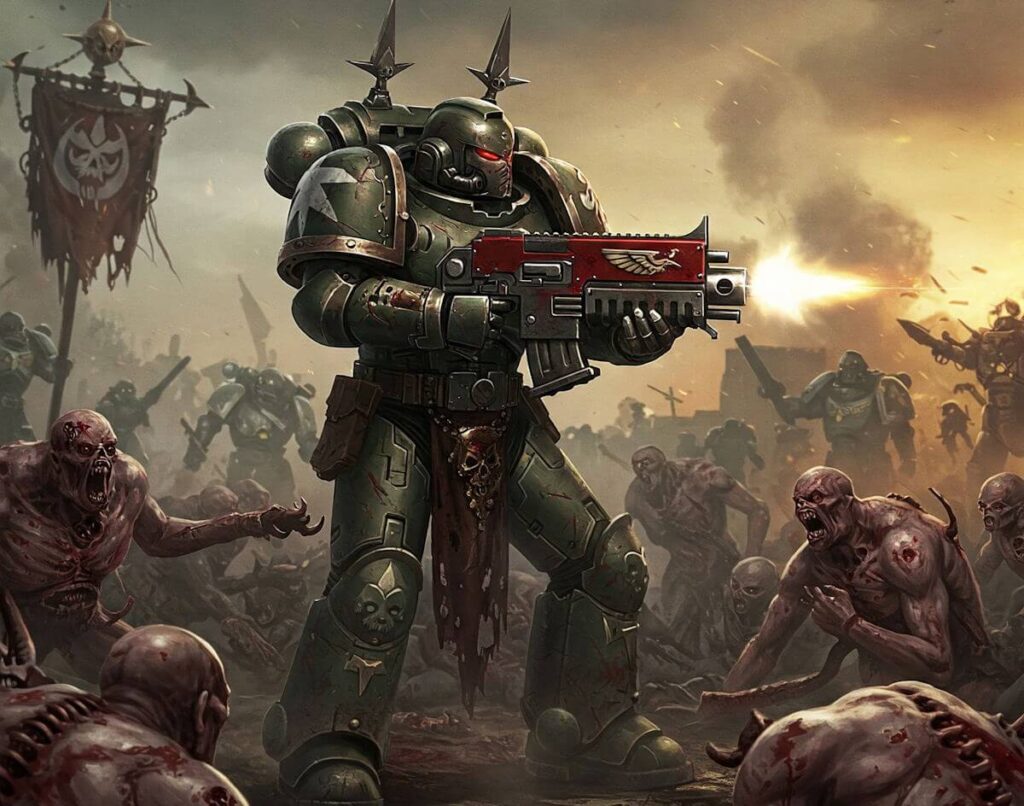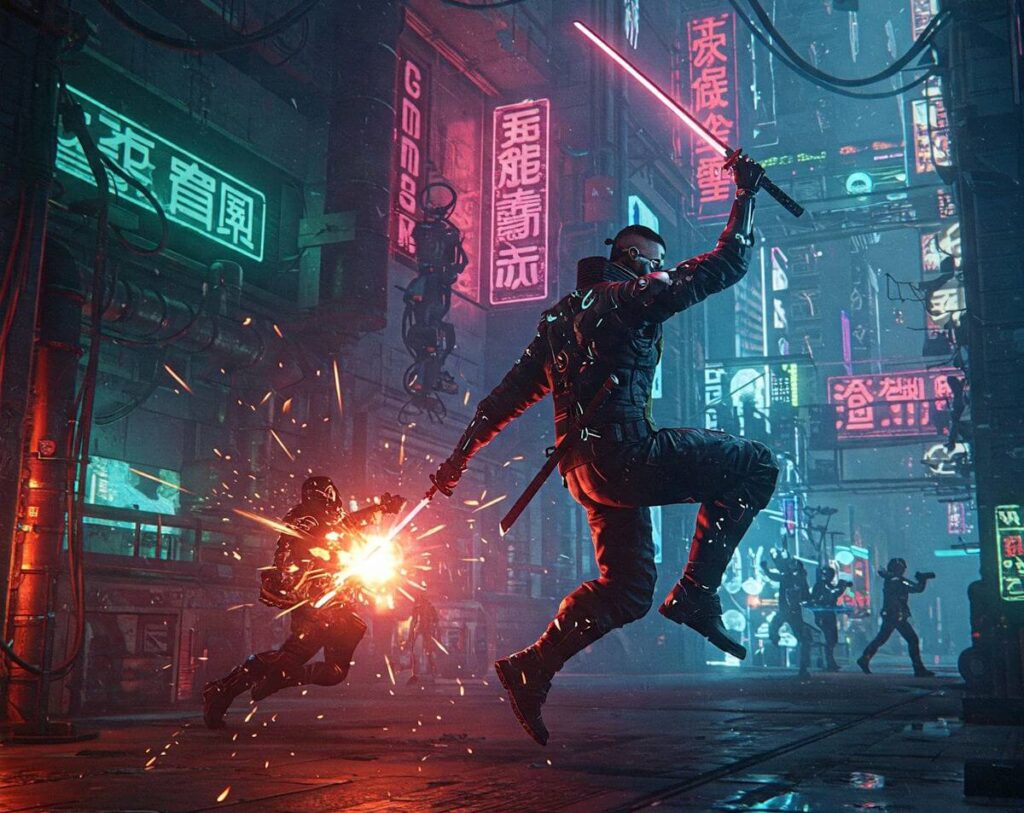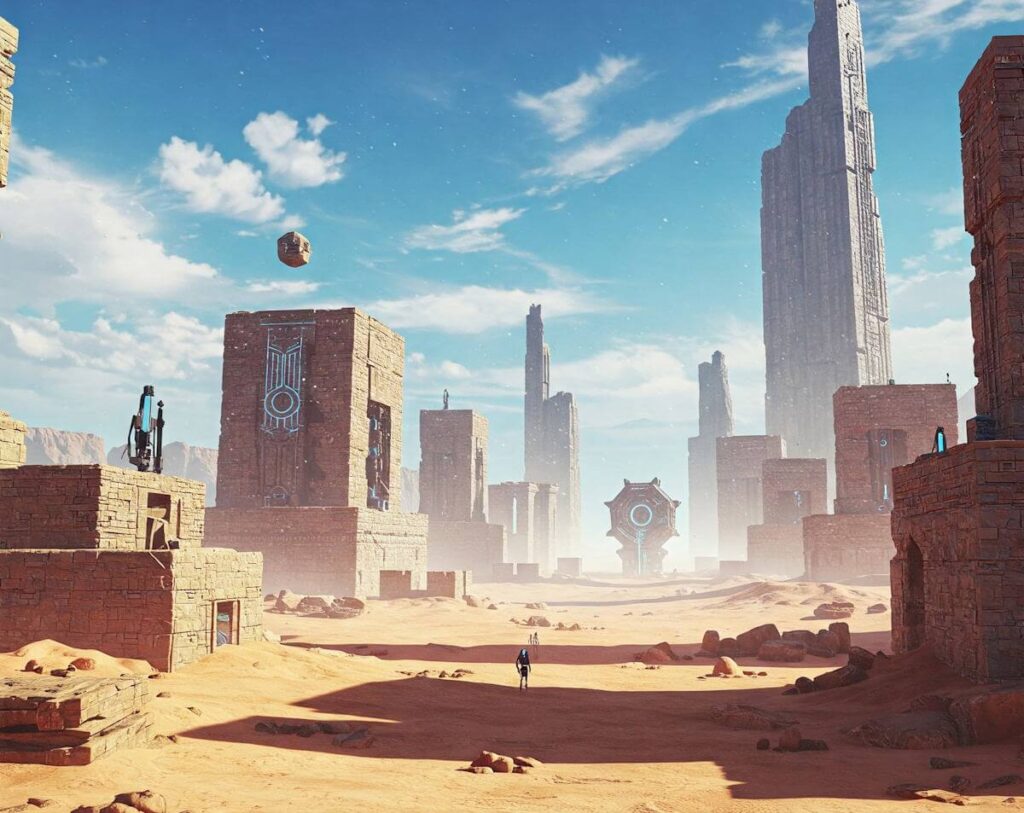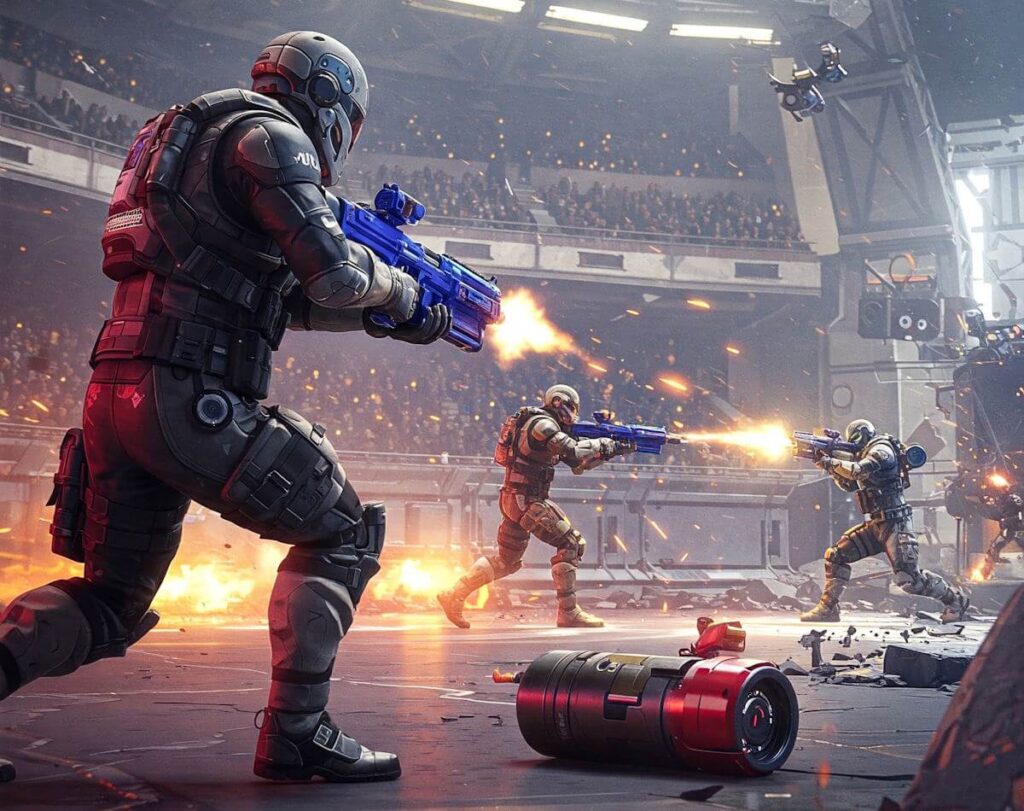Released on May 23, 2023, Warhammer 40K: Boltgun is a first-person shooter that immerses players in the iconic Warhammer 40K universe. Developed by Auroch Digital and published by Focus Entertainment, this game appeals to both long-time fans of the franchise and newcomers alike. The standout feature of this title is its marriage of retro-inspired visual styles with the rich lore and themes of the Warhammer 40K setting, creating a distinct gaming experience that evokes nostalgia while delivering modern gameplay mechanics.
The gameplay in Warhammer 40K: Boltgun revolves around the relentless combat and dark aesthetics for which the Warhammer 40K series is known. Players take on the role of a formidable Space Marine, equipped with an array of powerful weapons, including the titular Boltgun. The narrative is infused with the franchise’s characteristic themes of war, sacrifice, and honor, inviting players to engage in fast-paced action against a variety of enemies. As players navigate through battlegrounds, they encounter both familiar foes from the Warhammer universe and unique adversaries created specifically for this title.
The visual style of Warhammer 40K: Boltgun is particularly noteworthy, as it evokes the classic first-person shooters of the 90s while cleverly intertwining the dark, gothic aesthetics familiar to Warhammer fans. This artistic choice not only enhances the game’s authenticity but also serves as a thoughtful homage to the genre’s roots. The integration of original soundtracks and sound design further enriches the gaming atmosphere, making players feel immersed in the brutal landscapes of the Warhammer 40K galaxy.
In summation, Warhammer 40K: Boltgun represents a bold addition to both the Warhammer franchise and the first-person shooter genre. Its unique blend of retro styles and modern gameplay opens a dialogue about its place within the broader gaming landscape.
Understanding Doom Clones
The term “Doom clone” refers to a category of first-person shooter (FPS) games that emerged in the wake of id Software’s landmark title, Doom, released in 1993. These games capture the essence of Doom’s groundbreaking gameplay mechanics, level design, and overall aesthetic. At their core, Doom clones prioritize fast-paced action, uncomplicated environmental navigation, and a focus on combat, often featuring similar weapons and enemy designs that evoke nostalgia for the retro FPS era.
One of the defining characteristics of Doom clones is their level design. They typically embrace a linear progression within interconnected environments, allowing players to navigate through a series of increasingly difficult challenges. This design philosophy encourages exploration and discovery, where players must solve puzzles or locate keys to advance, harkening back to the early days of gaming that favored exploration over the open-world mechanics found in more recent titles. The levels are often marked by secret rooms and traps, a nod to the secrets that players would uncover in the original Doom, adding layers to the gameplay experience.
Another key aspect of Doom clones is their aesthetic, which often draws heavily from 1990s graphics. Textures, character models, and environments in these games may mimic the pixelated, sprite-based graphics that became iconic during that time. The retro visual style, combined with modern enhancements, can evoke a sense of nostalgia while appealing to a new generation of players. The sound design also plays an important role, with heavy, energetic soundtracks and retro sound effects that further immerse players in the experience.
Historically, Doom had a monumental impact on the gaming industry, influencing countless developers and spawning numerous sequels and clones. The game established a template for FPS games and set standards in multiplayer gameplay, level design, and modding capabilities. This legacy continues to manifest in modern games that seek to capture the essence of what made Doom revolutionary, fueling the ongoing interest in Doom clones and their evolution within the gaming landscape.
Gameplay Mechanics of Boltgun
Warhammer 40K: Boltgun showcases a distinct gameplay experience that pays homage to the labyrinthine battles and frantic pace found in classic Doom games. Players navigate expansive levels filled with treacherous foes, emphasizing fluidity and speed in movement. The controls are intuitive yet responsive, allowing for seamless transitions between actions, thus enhancing overall player engagement. Players can expect to execute a variety of maneuvers, from quick dodges to rapid directional changes, emulating the agility that characterized the earlier shooters.
A true strength of Boltgun lies in its combat systems, which reflect both the ethos of the Warhammer universe and the adrenaline-inducing mechanics found in its predecessors. The game offers a wide range of weapons, each with its unique characteristics and upgrades. From traditional firearms to explosive armaments, players are provided with the tools necessary to tackle varied enemy types throughout the game. The arsenal caters to diverse playstyles, encouraging experimentation and the adoption of tactical approaches to each encounter, reminiscent of the versatility found in Doom’s weapon selection.
Enemy types in Boltgun enrich the gameplay experience, featuring a diverse array of adversaries that challenge players’ skills and strategies. Ranging from basic infantry to formidable bosses, these foes exhibit distinct behaviors and patterns, requiring players to adapt their tactics swiftly. This enemy variety enhances the gameplay loop, encouraging players to refine their skills while tackling increasingly complex scenarios.
The essence of fast-paced gameplay, inseparable from classic shooters, is captured through smart design decisions in Boltgun, including level layout and enemy placement. Modern enhancements, such as strategic checkpoints and in-depth play mechanics, ensure that the exhilarating rhythm of traditional Doom gameplay is retained while appealing to contemporary sensibilities, thus providing gamers with an experience that honors its legacy while carving out its distinct identity.
Visual and Audio Aesthetics
Warhammer 40K: Boltgun brings forth a striking blend of nostalgic visuals and modern game design, capturing the essence of classic first-person shooters while incorporating contemporary artistic elements. The graphics in Boltgun pay homage to the retro aesthetic that characterized early FPS games, particularly the iconic Doom series. Players can expect pixelated textures that evoke a sense of nostalgia, coupled with a vibrant color palette that helps to differentiate the diverse environments and characters within the game.
The art style is where Boltgun truly shines; it establishes a distinct personality that combines grim dystopian themes with a whimsical charm. Each level is thoughtfully designed, echoing the level layouts of old-school shooters, yet with enough modern finesse to ensure it does not feel outdated. The environments vary significantly in design—from claustrophobic corridors to expansive arenas—facilitating not only engaging gameplay but also an immersive exploration of the Warhammer 40K universe.
In terms of audio aesthetics, the sound effects are both robust and engaging, successfully complementing the frenetic pace of combat. From the clatter of heavy weaponry to the eerie ambiance of desolate worlds, the soundscapes elicit a sense of urgency and danger befitting the grimdark saga. The soundtrack stands out as well, featuring pulsating rhythms that evoke a feeling of adrenaline reminiscent of retro gaming, while simultaneously aligning with the thematic elements of the Warhammer lore. This combination of sound effects and music plays a crucial role in enhancing the overall atmosphere.
Ultimately, the visual and audio aesthetics of Warhammer 40K: Boltgun work synergistically to cultivate a truly immersive experience. By drawing inspiration from the hallmark design principles of classic FPS games, the developers manage to create an engaging modern iteration that resonates with veterans of the genre and newcomers alike.
The Narrative and Themes of Boltgun
Warhammer 40K: Boltgun weaves an intricate narrative that unfolds within the expansive Warhammer universe, inviting players to engage with its deeply rooted lore and thematic elements. As players navigate through the chaotic landscapes, they encounter a universe steeped in the sanguine stories of galaxies at war, where the fight between Order and Chaos is perpetual. This narrative framework not only enriches the gameplay experience but also situates Boltgun firmly within the traditions of its predecessors, echoing the storytelling ethos that defines the Warhammer franchise.
Thematically, Boltgun explores the grim realities of war, a core element of the Warhammer 40K narrative. The game places players in the shoes of a Space Marine, a heroic yet tragic figure, embodying the values of duty and sacrifice amid a relentless onslaught of enemies. This portrayal of heroism resonates with themes prevalent in genre staples like Doom, where players embody unstoppable forces against overwhelming odds. Additionally, the chaos that permeates the game is reflected in the gameplay mechanics and design, showcasing an aesthetic that balances the brutal nature of conflict with a distinctive artistic direction.
Moreover, Boltgun delves into the concept of chaos, not merely as an adversarial force but as an ever-present backdrop that shapes the universe and its inhabitants. The game effectively utilizes this chaotic backdrop to heighten the sense of frenetic urgency, driving gameplay forward and motivating player actions. In contrast to other titles in the first-person shooter genre, where chaos might be merely a gameplay mechanic, Boltgun’s approach recognizes it as a contextual experience, integral to understanding the motivations and struggles of characters within the Warhammer lore. Through this synthesis of narrative and thematic depth, Boltgun positions itself as a compelling homage to its roots while delivering an engaging storyfull of conflict and heroism.
Community Reception and Reviews
The release of Warhammer 40K: Boltgun has generated a significant amount of buzz within the gaming community, particularly between fans of the Warhammer franchise and retro first-person shooters (FPS). Upon its release, early reviews from critics generally leaned towards a favorable perspective, highlighting the game’s nostalgic aesthetics reminiscent of 90s shooters, while also embracing the dense lore characteristic of the Warhammer universe.
Critics have praised the game’s visual style, which successfully captures the essence of classic FPS titles, from pixelated graphics to fluid animations. Reviewers often noted how the combination of low-poly design and vibrant color palettes evokes a sense of nostalgia for veteran gamers. Furthermore, the game’s mechanics have been split into segments that homage both the old-school FPS genre and the strategic depth Warhammer fans expect. Elements such as the variety of weapons and abilities received positive remarks for providing players with multiple playstyles and tactics to explore.
On the other hand, not all feedback has been overwhelmingly positive. Some players voiced concerns regarding level design, mentioning that certain areas may feel repetitive or linear, which can detract from the overall experience. There are also comments about the story depth; while most fans agree the lore aligns with Warhammer’s universe, some expressed a desire for a more intricate narrative that goes beyond the core gameplay. Additionally, balancing issues were raised concerning enemy difficulty and weapon effectiveness.
The community’s reception has also been noteworthy, with many fans expressing excitement on forums and social media platforms. This enthusiasm is particularly evident among those who appreciate both Warhammer 40K lore and the retro FPS genre, with many celebrating the game’s ability to merge these two beloved realms. Overall, Warhammer 40K: Boltgun appears to be carving out its niche, generating a blend of admiration, critique, and passionate discussion within its community.
Comparative Analysis: Boltgun vs. Classic Doom
When examining the relationship between Warhammer 40K: Boltgun and the original Doom, it is essential to consider key elements that define the ‘Doom clone’ genre. Gameplay mechanics are paramount in establishing this connection. Both Boltgun and classic Doom share a fast-paced, first-person shooter (FPS) format that thrives on quick reflexes and strategic weapon choices. In Boltgun, players navigate expansive levels utilizing an array of weapons reminiscent of the armory found within Doom. The design choices made in Boltgun advocate for visceral combat against a multitude of enemies, much like its predecessor. However, Boltgun introduces unique mechanics and a recognizable Warhammer universe flair, setting itself apart while remaining grounded in its roots.
Level design constitutes another pivotal aspect of comparison. The original Doom is renowned for its labyrinthine maps that incentivize exploration, revealing secrets and hidden passages, which enrich gameplay. Boltgun adheres to this principle, featuring intricately designed environments that capture the chaotic aesthetic of the Warhammer 40K universe. Levels are structured to balance combat encounters with exploration, allowing players to experience the thrill of discovery akin to the original Doom. However, while classic Doom’s simplicity strikes a nostalgic chord, Boltgun elevates complexity, often weaving narrative elements into its layout, which might appeal to a broader audience looking for depth in their gaming experience.
Nostalgia, a significant factor for many gamers, plays a crucial role in determining the allure of a title. The retro-inspired graphics and soundtrack in Boltgun evoke memories of the original Doom while appealing to modern sensibilities. This combination can elicit a sense of familiarity for long-time gamers, stirring emotions tied to their early FPS experiences. Ultimately, the analysis suggests that although Boltgun positions itself within the rich legacy of Doom, it successfully carves out its niche, blending the essence of classic gameplay with modern advancements that cater to contemporary audiences.
Future of the Franchise and Sequels
The future of the Warhammer 40K: Boltgun franchise appears promising, reflecting a growing interest among players and fans of the genre. Given the nostalgia associated with classic first-person shooters (FPS) and the successful melding of this format with the Warhammer 40K universe, it stands to reason that the game could pave the way for sequels that expand upon its unique gameplay mechanics and rich lore. Market trends indicate a renewed appetite for retro-style shooters, aligning well with the aesthetic and gameplay choices present in Boltgun.
Sales performance will play a crucial role in determining the viability of sequels. Early indicators suggest a strong initial reception, aided by favorable reviews and social media buzz. If this momentum continues, it can not only facilitate further development of additional content but also potentially attract new players who are drawn to both the Warhammer 40K universe and the gameplay style reminiscent of beloved classics. The engagement level of the player base can lead to community-driven initiatives, including modding or expansion packs, which are often key drivers in maintaining long-term interest.
As the franchise evolves, developers could explore various avenues for expansion. For instance, sequels may introduce new gameplay mechanics or narrative elements, drawing on the deep lore of Warhammer 40K to create compelling storylines and character arcs. Seasonal updates, thematic events, or cooperative modes could cater to diverse gameplay preferences while capitalizing on the preferences of the gaming community. The integration of multiplayer elements could further enrich the gaming experience, establishing Boltgun as a mainstay within the FPS genre and solidifying its place in the expansive Warhammer 40K franchise.
Conclusion: Boltgun’s Place in Gaming History
In assessing the impact of Warhammer 40K: Boltgun, it is essential to recognize its contributions to the gaming landscape, particularly within the first-person shooter (FPS) genre. As a title that embraces and revitalizes the retro aesthetics and gameplay mechanics reminiscent of classic Doom-like games, Boltgun serves as a noteworthy addition to both the Warhammer universe and retro FPS celebrations. By incorporating distinct elements from its predecessors while ensuring a fresh experience, the game creates a unique niche for itself, drawing in both dedicated Warhammer fans and newcomers to the genre.
Throughout the game, players encounter a blend of nostalgia and innovation, featuring classic level design, fast-paced action, and a distinct visual style that harkens back to the golden age of FPS gaming. Boltgun stands out due to its successful integration of the Warhammer 40K lore, translating the vast universe into a vibrant gameplay experience that feels both familiar and fresh. This successful fusion further cements its relevance in discussions about FPS titles that aim to recapture the charm of early gaming while also appealing to modern sensibilities.
As we delve into the evolution of FPS games over time, it becomes clear that titles like Boltgun play a significant role in redefining expectations and exploring new possibilities. The game not only appeals to existing franchise fans but also introduces the Warhammer 40,000 universe to a broader audience through engaging gameplay mechanics and captivating visuals. Consequently, Boltgun’s legacy lies not just in its gameplay, but also in how it bridges the past with the future of gaming, paving the way for a resurgence of interest in retro-styled FPS games with rich lore. Ultimately, Boltgun represents a significant milestone, embodying the spirit of classic gaming while carving out its own identity in a competitive landscape.




